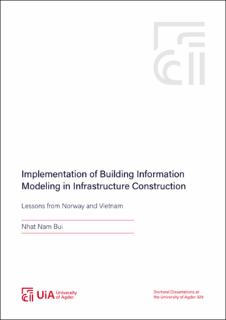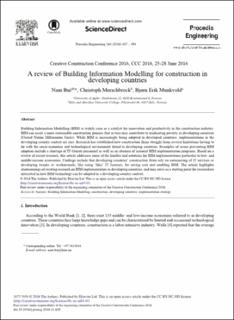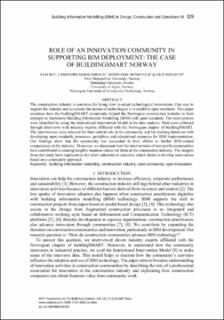| dc.contributor.author | Bui, Nhat Nam | |
| dc.date.accessioned | 2021-06-04T13:47:39Z | |
| dc.date.available | 2021-06-04T13:47:39Z | |
| dc.date.created | 2021-06-03T15:16:18Z | |
| dc.date.issued | 2021 | |
| dc.identifier.citation | Bui, N. N. (2021). Implementation of Building Information Modeling in Infrastructure Construction : Lessons from Norway and Vietnam [PhD. thesis]. University of Agder. | en_US |
| dc.identifier.isbn | 978-82-8427-034-0 | |
| dc.identifier.issn | 1504-9272 | |
| dc.identifier.uri | https://hdl.handle.net/11250/2757979 | |
| dc.description.abstract | Industrialization, innovation, and infrastructure are important drivers in improving employment and income (United Nations, 2015b). To meet the United Nation’s Sustainable Development Goals by 2030, developing countries need to invest more in research and innovation that aims to improve their infrastructure (United Nations, 2015a). More basic infrastructure, such as roads, information and communication technology (ICT) systems, and electrical power grids, is essential to improving standards of living and protecting the environment in developing countries (ibid.).
Construction researchers have found that the use of ICT increases construction efficiency. Adwan and Al-Soufi (2016) classified 21 sets of ICT technologies used in construction, including web-based platforms, Building Information Modeling (BIM) based technologies, CAD- and 3D CAD–based technologies, virtual reality, and video conferencing. Among these, BIM is an information system that facilitates digital collaboration in construction. BIM provides an environment for data sharing based on 3D models, and it has been used to increase productivity and quality of building construction. In the context of transportation infrastructure, BIM reduces errors, provides better understandings of projects, and improves project performance (SmartMarket Report, 2017). In my construction industry experience, 3D modeling was applied to infrastructure projects that include roads, bridges, and railways. 3D models of infrastructure, such as that related to railways (stations and line alignments) and bridges, was used to detect design clashes and support communication with stakeholders. More broadly, BIM implementation is rapidly increasing in the context of infrastructure construction (Bradley et al., 2016), and examples include the integration of 3D infrastructure models with other technologies, such as geographic information systems, global positioning systems, laser scanners, and photogrammetry (Bradley et al., 2016; Costin et al., 2018). Researchers have also reported on BIM applications in different phases of the infrastructure life cycles (ibid.). In general, BIM supports infrastructure construction by reducing costs and risks and increasing reliability (Costin et al., 2018). The trend of rising use shows BIM’s potential to benefit the infrastructure sector.
Infrastructure is critical if developing countries are to achieve their Sustainable Development Goals, which motivated me to explore BIM implementation in that context. Since developed countries is leading in BIM use, this thesis explores whether they can learn from the experiences of more advanced countries. To identify useful lessons, I conducted a comparative analysis of BIM implementation in a developed and a developing contexts. Moreover, BIM-related innovation communities were studied to understand how BIM practices can be further strengthened in infrastructure projects. This thesis focused on the following research question:
“How can the implementation of Building Information Modelling be improved to support infrastructure projects in a developing context?” | en_US |
| dc.language.iso | eng | en_US |
| dc.publisher | University of Agder | en_US |
| dc.relation.ispartofseries | Doctoral Dissertations at the University of Agder;no. 329 | |
| dc.relation.haspart | Paper I: Bui, N., Merschbrock, C. & Munkvold, B. E. (2016). A Review of Building Information Modelling for Construction in Developing Countries. Procedia Engineering, 164, 487-494. https://doi.org/10.1016/j.proeng.2016.11.649. Published version. Full-text is available in AURA as a separate file: http://hdl.handle.net/11250/2426302. | en_US |
| dc.relation.haspart | Paper II: Bui, N. (2019). Implementation of Building Information modeling in Vietnamese infrastructure construction: A case study of institutional influences on a bridge project. Electronic Journal of Information Systems in Developing Countries, 86(4): e12128. https://doi.org/10.1002/isd2.12128. Published version. Full-text is not available in AURA as a separate file. | en_US |
| dc.relation.haspart | Paper III: Bui, N., Merschbrock, C., Munkvold, B. E. & Lassen, A. K. (2018). An Institutional Perspective on BIM Implementation – a Case Study of an Intercity Railway Project in Norway. In B. Andersson, B. Johansson, S. Carlsson, C. Barry, M. Lang, H. Linger & C. Schneider (Eds.), Designing Digitalization (ISD2018 Proceedings). Lund University. http://aisel.aisnet.org/isd2014/proceedings2018/General/2. Published version. Full-text is not available in AURA as a separate file. | en_US |
| dc.relation.haspart | Paper IV: Bui, N., Merschbrock, C., Munkvold, B. E. & Hjelseth, E. (2019). Role of an innovation community in supporting BIM deployment: the case of building SMART Norway. In P. De Wilde, L. Mahdjoubi & A. Garrigós Garrigos (Eds.), Building Information Modelling (BIM) in Design, Construction and Operations III (vol. 192, s. 329-342). WIT Press. . Published version. Full-text is available in AURA as a separate file. | en_US |
| dc.title | Implementation of Building Information Modeling in Infrastructure Construction : Lessons from Norway and Vietnam | en_US |
| dc.type | Doctoral thesis | en_US |
| dc.description.version | publishedVersion | en_US |
| dc.rights.holder | © 2021 Nhat Nam Bui | en_US |
| dc.subject.nsi | VDP::Matematikk og Naturvitenskap: 400::Informasjons- og kommunikasjonsvitenskap: 420 | en_US |
| dc.subject.nsi | VDP::Teknologi: 500::Bygningsfag: 530 | en_US |
| dc.source.pagenumber | 184 | en_US |
| dc.identifier.cristin | 1913608 | |


